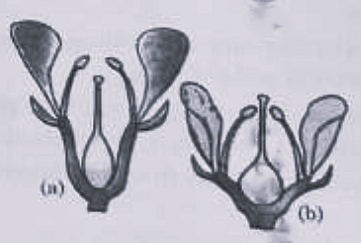Question:
The presence of corollary corona, sagittate anthers and dumb-bell shaped stigma are the characteristic features of_____________
The presence of corollary corona, sagittate anthers and dumb-bell shaped stigma are the characteristic features of_____________
Updated On: Apr 17, 2024
- Hibiscus rosa-sinensis
- Musa paradisiaca
- Ravenala madagascariensis
- Catheranthus roseus
Hide Solution
Verified By Collegedunia
The Correct Option is D
Solution and Explanation
Catharanthus roseus (Vinca rosea) belongs to Apocynaceae family (Oleander family). It is commonly known as periwinkle. It is an ever blooming herb with pink and white flowers. It yields an alkaloid named vinca leucoblastine (VLB) and vincristine (VC) used in studies on cell division. It has corollary corona, sagittate anthers or arrow shaped anthers and its stigma is capitate or dumb
bell shaped.
bell shaped.
Was this answer helpful?
0
0
Top Questions on The Flower
- Identify the set of correct statement:
A. The flowers of Vallisneria are colourful and produce nectar.
B. The flowers of waterlily are not pollinated by water.
C. In most of water-pollinated species, the pollen grains are protected from wetting.
D. Pollen grains of some hydrophytes are long and ribbon like.
E. In some hydrophytes, the pollen grains are carried passively inside water.
Choose the correct answer from the options given below- NEET (UG) - 2024
- Biology
- The Flower
- Match List I with List II
List I (Types of Stamens) List II (Example) A Monoadelphous I Citrus B Diadelphous II Pea C Polyadelphous III Lily D Epiphyllous IV China-rose
Choose the correct answer from the options given below:- NEET (UG) - 2024
- Biology
- The Flower
- Which of the following is an example of actinomorphic flower?
- NEET (UG) - 2024
- Biology
- The Flower
- Identify the type of flowers based on the position of calyx, corolla and androecium with respect to the ovary from the given figures (a) and (b).

- NEET (UG) - 2024
- Biology
- The Flower
- Identify the correct description about the given figure.

- NEET (UG) - 2024
- Biology
- The Flower
View More Questions
Questions Asked in KCET exam
- If the number of terms in the binomial expansion of \((2x + 3)^n\) is 22, then the value of \(n\) is:
- KCET - 2025
- Binomial theorem
- Ethyl alcohol is heated with concentrated sulphuric acid at 413 K (140°C). The major product formed is
- KCET - 2025
- Organic Chemistry
- A body of mass 0.25 kg travels along a straight line from \( x = 0 \) to \( x = 2 \, \text{m} \) with a speed \( v = k x^2 \) where \( k = 2 \, \text{m}^{-1} \). The work done by the net force during this displacement is
- KCET - 2025
- Elastic and inelastic collisions
- A square loop of side 2 m lies in the Y-Z plane in a region having a magnetic field \(\mathbf{B} = (5 \hat{i} - 3 \hat{j} - 4 \hat{k}) \, \text{T}\). The magnitude of magnetic flux through the square loop is
- KCET - 2025
- Magnetic Field
- A random experiment has five outcomes \(w_1, w_2, w_3, w_4, w_5\). The probabilities of the occurrence of the outcomes \(w_1, w_2, w_4, w_5\) are respectively \( \frac{1}{6}, a, b, \frac{1}{12} \) such that \(12a + 12b - 1 = 0\). Then the probabilities of occurrence of the outcome \(w_3\) is:
- KCET - 2025
- Probability
View More Questions
Concepts Used:
Structure of a Flower
The flower structure comprises four major parts or whorls—known as the calyx, corolla, androecium, and gynoecium.
Diversity of Flowers:
Flowers come in a range of sizes and shapes, but their anatomy, in general, is the same: sepals, petals, stamen, and carpel. A whorl, or circular positioning, is created by arranging these parts in a circular pattern.
Flowers come in various forms:
- Complete flower - The sepals, petals, stamens, and pistil all constitute a complete flower.
- Incomplete flower - An incomplete flower is one that lacks one or more of these structures.
Parts of a flower:
- Vegetative Part: A flower's vegetative component comprises the following:
- Petals
- Sepals
- Reproductive Part: Flowers consist of the reproductive organs of the plant. A flower's reproductive parts involves the following:
- Pistil
- Stamen
- Leaf
- Stem
- Receptacle